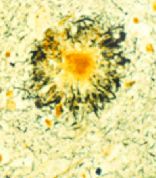Chelation therapy meets nanotechnology

One option for treatment is chelation.
Chelation therapy is the process by which positively-charged metal ions are captured and then removed from the body by a large chelating molecule.
In practice chelation has not been very effective. There are side effects, and older chelation agents have difficulty getting to brain cells (ie, crossing the blood-brain barrier). But now, preliminary evidence suggests that nanotechnology might overcome these problems.
In the lab, nanoparticles have been used to transport chelators and chelator-metal complexes in both directions across the blood-brain barrier. Further research will be needed to prove it is a safer and more effective treatment in Alzheimer’s disease — and in other neurological diseases.
Illustration: Neurofibrillary tangles and fiberlike processes of neurons (black) surround an amyloid plaque. Source: Chemical and Engineering News
8/28/06 18:44 JR